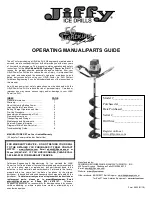
3-2
15. If it is necessary to work on the boom in an unstowed condition, block it to prevent it from
dropping unexpectedly.
16. Use a hoist when lifting components that weigh 50 pounds (22 kg) or more. Follow all hoist
and rigging safety rules.
17. Do not use lower grade fasteners if replacements are necessary.
18. When reinstalling wiring or plumbing after repairs, be sure that it will not be damaged by
rubbing against sharp, rough, or hot surfaces or edges.
19. Never use a rope clip on live side of the load hoist rope. This will seriously weaken the
rope. Death or serious injury can result from the misuse of a rope clip on the hoist rope.
20. Replace any instruction or warning placards that are lost or damaged, or not readable.
21. Always replace all guards and covers after working on the crane.
22. After working on the hydraulic system, remove air from the lines and cylinders involved by
cycling them full stroke with the engine running, until the functions operate smoothly.
23. When welding on the crane or on anything connected to the crane by wire rope or other
conducting link, disconnect the battery, the Rated Capacity Limiter components, controls
system and its computer, transmission shifter, main VEC, optional camera monitor, lower
control valve, and the engine electronic control module. When welding on the boom or turn-
table assembly, disconnect the cable reel, cylinder transducers, boom control valve, and any
other electronic components connected above the slip ring.
24. When using pressure spray to clean the crane, cover all electronic components with sheets
of plastic to protect them from spray.
25. Do not allow antifreeze to contact skin. Rinse off spills immediately with plenty of water.
Antifreeze is highly toxic if ingested.
26. Always disconnect negative cable first and refasten last to prevent accidental short through
chassis components.
27. Dispose of all hazardous substances properly by following local regulations.
CAUTION
Even with low voltage electrical systems, severe arcing can occur. Electrical shock or
component damage can result from contact with energized conductors. Use caution
when working with any electrical device.
Summary of Contents for RT-400-A
Page 6: ......
Page 7: ...1 3 RT 400 A TURNING DIMENSIONS...
Page 14: ......
Page 34: ...2 20...
Page 35: ...2 21...
Page 36: ...2 22...
Page 56: ...3 9 RT 400 A LUBRICATION CHART...
Page 57: ...3 10 RT 400 A LUBRICATION CHART...
Page 58: ...3 11 RT 400 A LUBRICATION CHART...
Page 74: ......
Page 86: ...3 39 BOOM CHAIN ADJUSTMENT...
Page 92: ......
Page 93: ......
















































